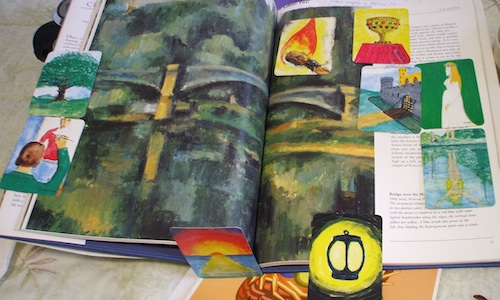OH and the Expressive Arts
I first saw the original OH Cards deck about 15 years ago, while visiting The Haven, a retreat centre on Gabriola Island in British Columbia. I was intrigued. Stories and storytelling have been a major part of my life for as long as I can remember.
A few years later, after graduating from the Expressive Arts postgraduate program at Fleming College’s Haliburton Campus in Ontario, Canada, I bought my first deck of OH Cards.
I currently teach in the Expressive Arts program from which I graduated. I’m a Registered Expressive Arts Consultant/Educator (through the International Expressive Arts Therapy Association – IEATA). In addition to teaching, I see clients as an expressive arts practitioner, and I’m also a storyteller and artist.
Expressive arts as a practice is an intermodal process where as much emphasis is placed on the creative process as on the end product. People move between mediums to shine a light on emerging themes – to say something in a different way, to discover, to amplify and explore, to make the invisible visible. We may begin by making visual art and take our exploration into movement. Or we may begin with movement and go on to do sculpture or create stories or poetry.
I use OH Cards in the courses I teach to introduce students to expressive arts as a field of practice and to share ways of planning expressive arts experiences that include storytelling as a modality. The students love the cards and I encourage them to find new ways to use them.
When we talk about OH Cards, we discuss the kinds of clients we would use the cards with and how and when we would use them, including when we would not use certain decks, given our training, experience, and comfort levels.
Although I’m not a therapist, I know that expressive arts can be therapeutic. Expressive arts is about authentic self-expression and can be instrumental in the areas of healing, personal discovery, building community, and social action.
Expressive arts participants don’t need to have any prior art-making experience whatsoever. My clients include seniors, kids at risk, the Canadian Mental Health Association, women at risk, and schools.
Visible Voices
My latest expressive arts work and research has been with seniors in a program I developed and delivered called Visible Voices: Through the Looking Glass, which used expressive arts to explore depression with seniors. We captured the essence of the program in the video Visible Voices.
During the Visible Voices program I often used OH Cards with a gentleman senior, using a baking sheet to hold the cards on his bed. I used the SAGA and/or the MYTHOS decks. I didn’t remove any of the cards from the deck and I shuffled them well before we used them. I would fan out the cards face down and he would pick cards one at a time. In that way, we built a story together. From week to week, he often drew the same card. It’s always intriguing when that happens!
Sometimes we discussed the card he drew and he would tell me what it reminded him of; what the characters on the card might be saying, thinking, or feeling; what had happened before the picture; or what might happen after the picture. All of that engaged his imagination and informed the story being created. The cards became a bridge into conversations between us which might otherwise not have happened.
That gentleman and I discovered a mutual love of bridges, literal and figurative. In one session, I showed him a Cezanne painting of a bridge and he randomly drew one card at a time from a facedown fan of the cards and told me where to place the cards on the painting. Taking turns, we came up with a short sentence for each card. In that way, we built the experience up into quite a wonderful improvised metaphorical story.
OH with Students
In the Expressive Arts program, we have used OH Cards (groups of cards, or the ECCO deck in particular) to inspire the expression of stories through body/movement/dance, using no words. Sometimes we do this is small groups. It’s a very powerful process to witness.
To encourage creative engagement, I have also invited people to choose cards randomly. For example, one or more cards are selected and placed on paper. Students expand the image by painting or drawing beyond the card in all directions. The completed piece is then held up and the artist who created it moves/dances to it, expanding the art-making into a movement dialogue. Going further, shifting modalities once more, the student contains their experience in a haiku poem or short story.
Sometimes other participants were invited to respond to the whole art piece using their bodies, vocal sounds, percussion instruments, etc. While, of course, there’s something for the creator in the making of art, there is also value for those who witness someone’s authentic expression. We are all connected.
The World of OH
I absolutely love using OH Cards, professionally and personally. They can be playful, yet meaningful. They can spark imagination, taking us into a world where everything is possible, which is so precious when the storyteller/client has little control over his or her environment.
OH Cards are solution-oriented. They offer delightful surprises and give us visual invitations to go deeper. They can be offered to people of almost all ages, backgrounds, and abilities (with some discernment), and they can be an integral part of an expressive arts experience.
I could go on and on about OH Cards! I relish this opportunity to share about the work I do and the ways OH Cards help me do it.
Fay Wilkinson designs and delivers expressive arts experiences for individuals and groups of all ages, and continues to research the impact of this work on health and wellbeing.

